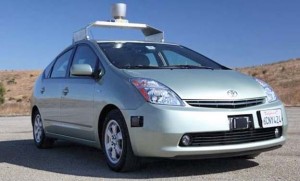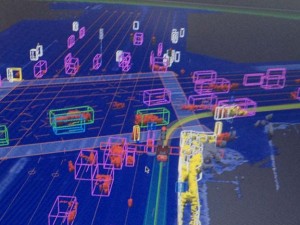At this month’s Geneva Motor Show, Swiss design firm Rinspeed is showing off an autonomous concept vehicle that would allow the driver and front seat passenger to swivel their seats 180 degrees to commune with those in back, much like a living room on wheels. Others have begun to imagine the idea of taxis and trucks that can wander the roads without a driver at all.
And that has regulators racing to catch up. Several states have already passed preliminary rules for manufacturers testing their early prototypes. And in Nevada and Michigan, that means there still needs to be a licensed driver sitting behind the wheel ready to take control in an instant if there’s a problem. There’ll be no texting, reading, shaving – or drinking, for that matter.
But California’s Department of Motor Vehicles is trying to look beyond and ask what happens when autonomous vehicles are actually on the road and in the hands of consumers, whether being operated by a commuter, a taxi driver or a truck fleet operator. And the questions are taking on an air of increasing urgency considering that Nissan last year said it hopes to quickly take the technology out of the realm of science fiction and make it a reality by 2020.
Many of today’s more expensive vehicles already have some of the technical stuff that will ultimately lead to self-driving cars. Even the little Audi A3 that will launch this spring will be able to raise and lower its speed to automatically go with the traffic flow, automatically stopping in a traffic jam and starting up again when traffic gets moving. One version of the 2014 Infiniti Q50 sedan has a steer-by-wire system that can track your lane and handle gentle curves entirely on its own.
(Rinspeed XchangE concept explores the future of autonomous driving. Click Here to check it out.)
Andy Palmer, head of Nissan’s global product development, expects to be selling a vehicle by decade’s end that can take over the rest of the driver’s duties. But most experts believe that, at least initially, a driver will need to remain at the ready in the event the vehicle has a problem.
“I can’t imagine a specific date when I’d be happy having my mom completely dependent upon one of these vehicles,” cautions Prof. Edwin Olson, of the University of Michigan’s electrical engineering and computer sciences department, and one of the leads in the school’s autonomous driving program. But he adds that remains the longer-term goal.
How to regulate autonomous vehicles in the near-term? And how to handle them as the technology improves and they become capable of operating entirely on their own are questions California regulators are asking in a series of meetings that began this week.
They don’t have much time to figure it out. State legislators passed a law requiring the DMV to act by the end of the year. Indeed, Silicon Valley-based Google is already out in front of regulators. The high-tech firm publicly revealed its own autonomous vehicle program in October 2010 and has become one of the unexpected researchers leaders in the field, its prototypes already logging 100s of thousands of miles of testing, albeit always “manned by trained operators,” according to one company statement.
(Study finds most American motorists still worried about driving in an autonomous vehicle. Click Here for more.)
Will drivers need to be sitting behind the wheel? Few expect to see a cab with no one up front anytime soon, but that’s likely to be a topic of discussion. And it remains to be seen whether the California DMV will be more accommodating with what “trained operators” who do serve backup duties will be able to do as they effectively just go along for the ride.
Another key question will revolve around vehicle safety. As the constant flow of recall notices – and the big flap about GM’s fatal ignition switch problem – illustrates, things go wrong. How will the state ensure that autonomous vehicles, with or without drivers, are safe enough to operate?
Will owners themselves face tougher scrutiny than they do today? Considering the state of dis-repair that many let their cars operate in today – driving for long periods at highway speeds on mini spare tires, for example – that’s a serious concern.
There are also the twin issues of privacy and security. Ford global marketing chief Jim Farley touched off a firestorm this year by suggesting the maker was able to learn much about what owners were doing with the infotainment and black box systems now in use on many of its vehicles. With car-to-car communications systems in development, the potential for a Big Brother environment becomes even more of an issue. On the flip side, there’s also the concern that hackers could take control of a vehicle, whether to steal it or cause other mischief.
(Vehicles may soon “talk” to one another in bid to reduce accidents. Click Herefor the latest.)
California may not be able to cover all the possibilities in its first go-round and simply mimic the limited autonomous vehicle rules passed by three other states. But DMV attorney Brian Soublet said a draft of regulations will be available by June, with the department hoping to have the rules ready for the road by year-end.



Do people really think that cars are ready for 100% autonomous operation?
Maybe that’s why some folks are practicing now with texting, cellphone use and other distracted driving techniques so they will be ready for their autonomous car – assuming they aren’t dead by the time it arrives…